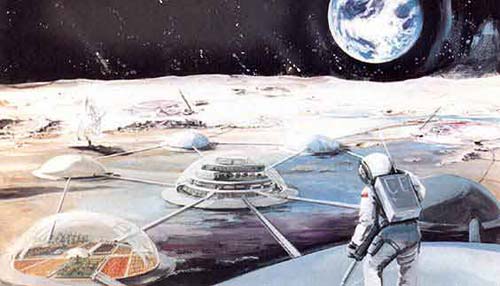Landing on the Moon – establishing a base – exploring Mars are goals set by the United States since 2004. Recently, the National Aeronautics and Space Administration (NASA) has outlined a plan.
Although a detailed “timeline” for the space exploration project was previously established, this plan is now facing significant challenges in its implementation.
According to scientists, NASA is currently focusing the majority of its finances and capabilities on improving safety for spacecraft and maintaining the International Space Station, making the idea of sending a new spacecraft to the Moon before 2020 very difficult to achieve.
NASA is now adjusting its research workforce and preparing designs for a new lunar exploration device, which will incorporate many new functions. A specific plan will be announced in the latter half of this year.
 |
|
A design for a future lunar base. |
Finding a Base Location
Once astronauts successfully land on the Moon, they may need to spend about 2-4 years constructing a base there.
In the initial phase of the “Moon Action” plan, astronauts will “strike” several “target areas” to determine the best location for building the base.
Before finalizing the selection of a “permanent base,” they will take turns working on the Moon, with each group consisting of four people and each work period lasting from 7 to 10 days.
Scientists believe that the “South Pole” region of the Moon is the top choice for base construction.
Although this area has a rugged terrain, it is also likely to have abundant water and sunlight. However, some scientists are skeptical about the presence of ice here; if the water source in this area is insufficient, NASA may consider a flatter location instead.
After the site selection process concludes, the next mission for the astronauts is to build a “working room.” Due to the similar harsh environmental conditions, scientists are likely to model it after the current U.S. base in Antarctica.
America’s Lunar Conquest: The Obstacles…
Even if scientists can overcome all technical obstacles, long-term habitation on the Moon remains the riskiest plan.
They cannot yet determine how the astronauts’ health will be affected under harsh environmental conditions and prolonged weightlessness, not to mention the life-threatening dangers during exploration.
One of the reasons for the time pressure on the U.S. is that recently, major powers are competing to achieve milestones in lunar exploration programs.
In the plan to build a base on the Moon, the U.S. also faces numerous challenges, especially regarding energy, spacesuits, dust, and lunar toolkits.
Energy: Solar energy is the primary choice for power generation if a base is to be established on the Moon. However, in the “South Pole” region of the Moon, which receives the most sunlight, the length of day and night can be as much as 14 days apart. This means that scientists must find alternative methods to endure the 14-day “hibernation” period.
Spacesuits: The spacesuit used during the Apollo missions weighed 270 pounds (over 100 kg). On the Moon, they weigh around 40 to 50 pounds (15-18 kg), making them relatively suitable for astronauts. However, if used on Mars, the weight of the suit could increase to 102 pounds (38 kg), making movement extremely difficult for astronauts. Therefore, designing a more streamlined and lightweight spacesuit is essential.
Dust: After landing on the Moon, astronauts have complained about dust accumulating in the joints of their suits. Future activities on the Moon will be more complex and prolonged, so creating a dust-free environment for the lunar base is one of the research goals.
Lunar Toolkits: Due to the unique environment on the lunar surface, the tools sent there must be specially designed, possibly resembling rudimentary tools from the 19th century, such as cables and sleds.
Tuyết Nhung

















































